The subject of Chapter 9 is that of the fifth and sixth trumpets, or first and second woes. Since Chapter 8 ends with a warning of the coming three woes “by reason of the other voices of the trumpet of the three angels, which are yet to sound,” this chapter is clearly sequential to the previous four trumpets which began to sound after Jesus “cast” the “censer . . . into the earth” signifying the close of probation (Revelation 8:5). [1]
By this time, we should begin to realize that the chapters of Revelation are hard wired to each other with all being closely related, although, retrospective flashbacks and prospective looks forward are frequently introduced to fill in the details of John’s visionary scenario. [2]
Unfortunately, such a straight-forward, easily understood interpretation places us at odds with the historic perspective. And, according to a statement in the book The Great Controversy by E.G. White, there appears to be good support for the historic understanding of this chapter. It reads as follows: “In the year 1840, another remarkable fulfillment of prophecy excited widespread interest. Two years before, Josiah Litch, one of the leading ministers preaching the second advent, published an exposition of Revelation 9, predicting the fall of the Ottoman empire, and specifying not only the year but the very day on which this would take place. According to this exposition, which was purely a matter of calculation on the prophetic periods of Scripture, the Turkish government would surrender its independence on the eleventh day of August, 1840. The prediction was widely published, and thousands watched the course of events with eager interest.
“At the very time specified, Turkey, through her ambassadors, accepted the protection of the allied powers of Europe, and thus placed herself under the control of Christian nations. The event exactly fulfilled the prediction.” [3] The last sentence, in the opinion of many, nails it to history―an unqualified endorsement of the historic interpretation, not only of Chapter 9, but, it is assumed, of all the forgoing trumpets of Chapter 8, notwithstanding the clear Biblical evidence that they do not sound until after the close of probation (Revelation 8:2-6) and the release of the “four winds” (Revelation 7:1-3). Few, it seems, are aware that White wrote an equally authentic statement in the context of “the battle of Armageddon,” saying: “Solemn events before us are yet to transpire. Trumpet after trumpet is to be sounded, vial after vial poured out one after another upon the inhabitants of the earth. Scenes of stupendous interest are right upon us.” [4] (italics supplied)
Some, assuming such a statement to be contradictory, view this as just another example of inconsistency, and completely abandon White’s writings. Others simply ignore such statements and put them on the back burner, while holding fast to the historic perspective which often fails to square with the Bible. Either position is unacceptable. While the former eventually leads to an abandonment of the Bible, itself, the later encourages us to place more confidence in the interpretations of man rather than allowing the Bible to be its own expositor. [5] Allowing the book of Revelation to be its own expositor, it is plain to see that White’s later “trumpet after trumpet” statement, placing the trumpets and the plagues in the future and making them sequential, surely harmonizes with John’s vision.
After quoting Josiah Litch’s interpretation of Revelation 9, predicting the fall of the Ottoman empire and following events, White concludes: “When it became known, multitudes were convinced of the correctness of the principles of prophetic interpretation adopted by Miller and his associates, and a wonderful impetus was given to the Advent movement. Men of learning and position united with Miller, both in preaching and publishing his views, and from 1840 to 1844 the work rapidly extended.” [6] Therefore, it was Litch’s interpretation, not White’s. Nowhere does she say it is the true interpretation. Rather, it was the interpretation that gave “impetus . . . to the Advent movement . . . from 1840 to 1844,” even though she probably did hold to the historic view, at least prior to 1844.
Consider that while the first edition of the Great Controversy was written in 1884, [7] her “trumpet after trumpet” statement appeared six years later in an article that was written December 22, 1890. [8] While White may have considered the historic application of the trumpets valid in 1884, God must have broadened her viewpoint later on when she wrote that they are still “before us” and are “yet to transpire.” “As for herself, she wrote: ‘I was astonished at the things shown me in vision, Many things came directly across my own ideas.” [9] The future view of the trumpets may well have been one of the “things” that came “across” her “own ideas.”
Verse 1: And the fifth angel sounded, and I saw a star fall from heaven unto the earth: and to him was given the key of the bottomless pit.
Given that the “fourth angel sounded” near the end of the last chapter, the “fifth angel” is in obvious sequence, and we must consider Chapter 9 to be an 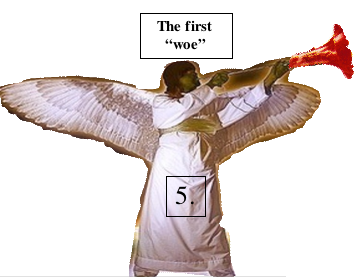 unbroken continuation of Chapter 8. Furthermore, since there are three more of the seven trumpets yet to sound, [10] which are identified in Chapter 8:13 as three “woes,” the sounding of this “fifth angel” is clearly the “first woe.” [11]
unbroken continuation of Chapter 8. Furthermore, since there are three more of the seven trumpets yet to sound, [10] which are identified in Chapter 8:13 as three “woes,” the sounding of this “fifth angel” is clearly the “first woe.” [11]
This star is actually the same person (Satan) as the star called “Wormwood” in Chapter 8 [12] who is disguised as Christ. Although both stars represent Satan, this time, in contrast to Wormwood, John identifies the star (Verse 11) as “Abaddon,” or “in the Greek tongue . . . Apollyon.” He is the “king” over the strange insects described in this chapter. His name “in English meant ‘Destroyer'” [13] and “and is obviously Satan . . .” [14]
In that case, both Abaddon and Wormwood are Satan―Abaddon as himself and Wormwood in disguise. In this passage, he reveals himself as a ruthless, intimidating “destroyer.” [15] He tyrannizes the avowed unbeliever, represented by the pale horse whose rider is named “Death” (Revelation 6:8). He is wholly unlike the well-mannered, lovable “Wormwood.”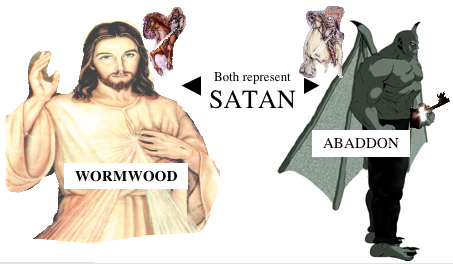
His “fall from heaven unto the earth” occurred when “there was war in heaven . . . And the great dragon was cast out, that old serpent, called the Devil, and Satan, which deceiveth the whole world: he was cast out into the earth, and his angels were cast out with him” (Revelation 12:7, 9).
He was not “given the key of the bottomless pit” until the “four angels standing on the four corners of the earth, holding the four winds” of Satanic malice were told to release them after the “servants of our God” had been “sealed . . . in their foreheads” and Jesus had “cast” the “censer . . . into the earth” (Revelation 7:1, 3; 8:5) signaling the close of probation. Prior to that Jesus held “the keys of hell and of death” (Revelation 1:18). Now, except for God’s sealed servants who have nothing to fear from him, Satan holds the “keys of hell and death” over the “children” of Jezebel who will be killed “with death” (Revelation 2:20, 23), the second death, represented by the metaphoric “bottomless pit.” [16]
After the scenario of the trumpets has been played out, it will be seen that Abaddon will dominate Wormwood, but not until Satan has set the stage for his primary objective, which is to force the whole world to worship at his feet as Abaddon the destroyer―not as Wormwood, the false Christ.
Interestingly, the metaphoric “bottomless pit” is referred to three times in this chapter, and four more times in Chapters 11, 17 and 20. While it is difficult, if not impossible, to explain its meaning from a historic viewpoint [17], it should be clear to us that it is a metaphor for post probationary time when mercy no longer pleads on behalf of sinners. As noted above, it is really a living death from which there is no escape.
Verse 2: And he opened the bottomless pit; and there arose a smoke out of the pit, as the smoke of a great furnace; and the sun and the air were darkened by reason of the smoke of the pit.
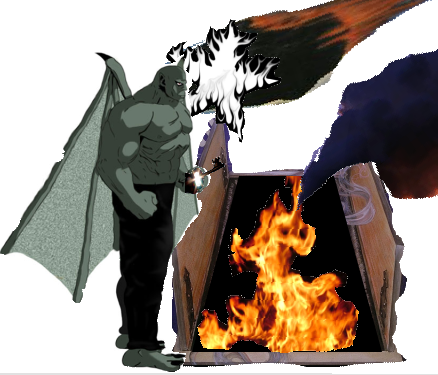 Since the “key” was given to Satan the moment the four angels released the “four winds of the earth,” it seems logical to conclude this “smoke” arose at the time “the third part of trees was burnt up, and all green grass was burnt up” (Revelation 8:7), which would produce enormous billows of suffocating smoke belting the whole world. Some may object to such a literal application, believing, like the Commentary, that this darkening is symbolic of “the obscuration of the sun of Christianity . . . the effect of the spread of the religion of Islam.” [18]
Since the “key” was given to Satan the moment the four angels released the “four winds of the earth,” it seems logical to conclude this “smoke” arose at the time “the third part of trees was burnt up, and all green grass was burnt up” (Revelation 8:7), which would produce enormous billows of suffocating smoke belting the whole world. Some may object to such a literal application, believing, like the Commentary, that this darkening is symbolic of “the obscuration of the sun of Christianity . . . the effect of the spread of the religion of Islam.” [18]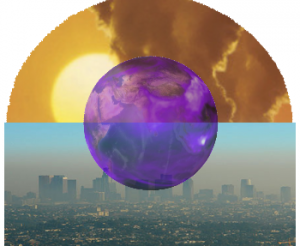
But there is a basic rule of interpretation, suggested by White, that should be considered when deciding what is literal and what is symbolic: “Revelation . . . records marvelous events that are to take place in the last days of this earth’s history. The teachings of this book are definite, not mystical and unintelligible.” [19] (italics supplied)
While the “great furnace” is clearly an analogy, similar to the “furnace” Moses used to describe the desolation of Sodom and Gomorrah (Genesis 19:28), the darkening of the “sun and the air” “by reason of the smoke” should be considered literal because it is just as “definite,” plain, unmistakable and distinct as the “smoke” arising from the ruins of Sodom and Gomorrah. Of course, if this prophecy must be considered from the historic perspective, the symbolic application would be mandatory because nothing like this has ever happened before, whereas in the future application, almost anything is possible.
Verse 3: And there came out of the smoke locusts upon the earth: and unto them was given power, as the scorpions of the earth have power.
The Commentary likens these “locusts” to “the plague of locusts that infested Egypt” back in the time of Moses, and to “the Moslem Arabs, who” overran “North Africa, the Near East, and Spain” [20] back in the 8th century A.D. From the historic perspective, such conclusions are probably the most logical. However, as we have just learned, these “events” are still “before us” and “are yet to transpire” and represent “scenes of stupendous interest” that “are  right upon us.” [4] We should also be able to advance a “definite,” non mystical, and intelligible explanation.
right upon us.” [4] We should also be able to advance a “definite,” non mystical, and intelligible explanation.
Before hazarding more than a guess as to what they represent, we must take all the features John uses to describe these “locusts” or “scorpions” into consideration. Note that the next seven verses describe their features and their activities.
Based on the information provided in this verse, a grasshopper with a scorpion’s tail is what seems to fit the description― “their torment was as the torment of a scorpion,” “they had tails like unto scorpions, and there were stings in their tails (Verses 5, 10). Because no such insect is seen in the natural world, we must look further before settling on a final conclusion. Let’s read on.
Verse 4: And it was commanded them that they should not hurt the grass of the earth, neither any green thing, neither any tree; but only those men which have not the seal of God in their foreheads.
These insects, unlike the natural ones who act by instinct, have the ability to obey commands, suggesting they possess intelligence with the power to distinguish what they should or should not “hurt.” The command not to “hurt the grass . . . and any green thing” or “tree” would be impossible for a natural grasshopper, because that is what it lives on. Therefore, this command suggests concern on the part of the commander for things that were “hurt” when “the first angel sounded . . . and the third part of trees was burnt up and all green grass was burnt up” (Revelation 8:7). They were to “hurt” only the people which failed to receive “the seal of God in their foreheads” [21] which was received just before Jesus cast the “censer . . . into the earth” (Revelation 7:4-10; 8:5). Therefore, these “insects” were either programed (AI?) or piloted by intelligences who had a spiritual agenda, an impossibility for a literal insect.
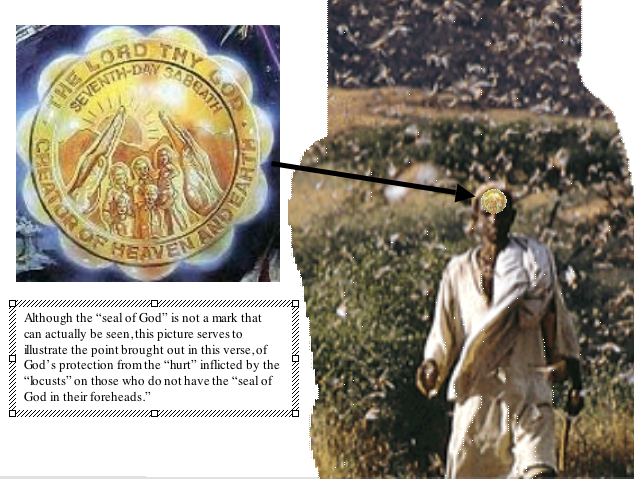 This moves them from the level of insects to the level of the human or even demons. Although we are not told how they are able to tell the difference between the sealed and unsealed people, we can guess. Recall the “fifth seal” (Revelation 6:9-11) depicting the time when the judgment passed from the dead to the living and “the test which the people of God must have before they are sealed” [22] was administered. Chapter 13 deals with that subject in more detail, but one thing is clear: “no man might buy or sell, save he that had the mark, or the name of the beast, or the number of his name” (Revelation 13:17). In that case, the identity of those who cannot engage in marketing, and those who can, will be readily apparent to anybody who cares, including the “locusts.”
This moves them from the level of insects to the level of the human or even demons. Although we are not told how they are able to tell the difference between the sealed and unsealed people, we can guess. Recall the “fifth seal” (Revelation 6:9-11) depicting the time when the judgment passed from the dead to the living and “the test which the people of God must have before they are sealed” [22] was administered. Chapter 13 deals with that subject in more detail, but one thing is clear: “no man might buy or sell, save he that had the mark, or the name of the beast, or the number of his name” (Revelation 13:17). In that case, the identity of those who cannot engage in marketing, and those who can, will be readily apparent to anybody who cares, including the “locusts.”
This verse also brings out the fact that at this time there will be “men” who had received “the seal of God in their foreheads.” That should remind us of the other “angel” who ascended “from the east” while exhorting the “four angels standing on the four corners of the earth” protecting “the earth . . . sea” and “trees” to continue holding the “four winds” until “the servants of our God” had been sealed “in their foreheads” (Revelation 7:1-3). Consequently, the “four winds,” representing the terrible power of Satan, will have been released, powerful evidence that these locusts are under the full control of Satan.
By this time, the first and second trumpets [23] have already been sounded, and the “earth, sea and trees” have already been “hurt.” Now, literal “men,” who were passed by when the sealing work by heavenly angels was being done, will be “hurt,” but, as the next verse shows, will not be destroyed.
Verse 5: And to them it was given that they should not kill them, but that they should be tormented five months: and their torment was as the torment of a scorpion, when he striketh a man.
As the Commentary notes: “The punishment inflicted by the locusts is pain, not death.” [24] Exactly how the “locusts” torture their victims, except for the scorpion-like stingers, is open to speculation. In other words, we will have to wait and see how it will really happen.
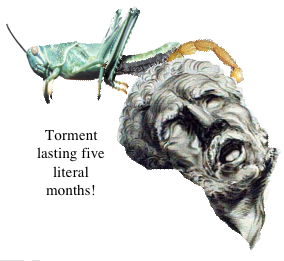 But now we are confronted with a very difficult decision to make. [25] If we desire to take the Bible just as it reads, [26] and allow it to be its “own expositor,” [27] this verse stipulates that the “torment” will last “five months” [28] during which those who are “tormented” will be alive throughout the entire period. Therefore, it is impossible to impose a prophetic, “day-for-a-year time” of “150 literal years” as the Commentary suggests. [29]
But now we are confronted with a very difficult decision to make. [25] If we desire to take the Bible just as it reads, [26] and allow it to be its “own expositor,” [27] this verse stipulates that the “torment” will last “five months” [28] during which those who are “tormented” will be alive throughout the entire period. Therefore, it is impossible to impose a prophetic, “day-for-a-year time” of “150 literal years” as the Commentary suggests. [29]
There is a parallel to this non-lethal attack in the book of Daniel where “the king of the south” merely pushes at “the king of the north” (Daniel 11:40), evidently without destroying him even though nothing is said about a torment. But remember, Revelation is the complement of the book of Daniel [30] and this seems to be another one of those “complements” or perfecting of what Daniel had to say.
Since Daniel named two antagonists in that conflict as the southern and northern kings, likewise, two antagonists in John’s vision can be identified as the “locusts” under the command of Abaddon, and the “men” deceived by “Wormwood” the false Christ. Since Abaddon commands the avowed unbeliever, they are represented by the pale horse whose rider is “Death” (Revelation 6:8). Wormwood, the false Christ, deceives the “believer,” represented by the “horse that was red,” whose rider takes “peace from the earth” and “there was given unto him a great sword” (Revelation 6:4).
Since the “locusts,” under the command of Abaddon, attack those who “have not the seal of God in their foreheads” (Revelation 9:4), they must be parallel to the “king of the south” who pushed “at . . . the king of the north . . .” (Daniel 11:40 first part). The verb “push” is translated from the Hebrew word “nagach” [31] meaning “to engage in thrusting, wage war.” Therefore, the southern king’s intent is to goad the northern king into retaliation. The act of “goading” implies hurting or annoying without killing, which is what we see here in John’s vision where the “locusts” engage in “tormenting” without killing. Their intent is also to goad the red horse, under the command of general “Wormwood,” into retaliation.
Verse 6: And in those days shall men seek death, and shall not find it; and shall desire to die, and death shall flee from them.
The phrase “in those days” refers to the entire “five month” period of torture. This attack, which causes “torment” rather than death, is strange indeed. Every antagonist seeks to cause as much destruction and death as possible, hoping to maximally disable the enemy in order to make it impossible for him to retaliate. But, since the “locusts” are “commanded . . . that they should not kill” the enemy but only “torment . . .” them for “five months,” their attack falls short of permanently disabling those who “have not the seal of God in their foreheads,” but have the “mark of the beast.” [32] What general, in his right mind, would issue such a command?!? Obviously, it is Satan deliberately playing one side against the other.
How about the attackers, do they have the “mark of the beast?” It does not make sense to believe they will be tormented along with their victims. Although this is speculative, [33] they probably will not have the “mark” at the time of the attack. Consider this possibility: when the “fifth seal” was opened, and the third trumpet sounded, “Wormwood” (Revelation 8:11), the false Christ, deceived professed Christians, [34] who had already accepted the “mark” in their “foreheads.”
On the other hand, the avowed unbeliever, [35] who initially accepted it “in their right hand” for purposes of expediency, were probably deceived by “Abaddon” [36] when “the fourth angel sounded, and the third part of the sun . . . moon . . . stars” “was smitten,” and “the day shown not for a third part of it, and the night likewise” (Revelation 8:12). If “Abaddon” is Wormwood’s enemy, he may have required his men to discard the “mark” that signifies loyalty to Wormwood.
Verse 7: And the shapes of the locusts were like unto horses prepared unto battle; and on their heads were as it were crowns like gold, and their faces were as the faces of men.
Here, John begins to give additional details of what “the locusts” looked like. Since he already said they looked like grasshoppers, then “scorpions,” he now adds “horses” to the picture. Obviously, what he was attempting to describe was something wholly unfamiliar to him. He was struggling to put into words what he actually saw, using the familiar to describe things completely unknown to himself and his readers. While the word “crowns” is from “stephanos,” which is a mark of royalty or emblem of victory given the victor in Greek games, this “crown” is a figurative description of what John actually saw, saying they “were as it were” (or something like it) and bares no moral or regal significance. Maybe, a halo might be closer.
Therefore, the general appearance of a grasshopper, a scorpion and a battle horse bear elements of similarity to what John actually saw. Granted, although this is a very crude attempt to picture what John saw, it includes all the elements called for in this verse and in the preceding verses. So, as crude as this illustration is, it should begin to give us an idea. So, let’s keep building on it and see what we can come up with.
Since we are nearing the time when the “fifth seal” is about to open, we should be able to put these elements together and know what John actually saw. But, before making the attempt, let’s move on through the next three verses.
Verse 8: And they had hair as the hair of women, and their teeth were as the teeth of lions.
 Along with looking like grasshoppers, scorpions, and horses, they now have “hair” that, evidently, streams out behind them, plus, things that look like “teeth,” probably at the front end of those creatures, decorating “their faces” like “the faces of men” (Verse 7). Obviously, those characteristics must be only analogous to what John actually saw and are not literal.
Along with looking like grasshoppers, scorpions, and horses, they now have “hair” that, evidently, streams out behind them, plus, things that look like “teeth,” probably at the front end of those creatures, decorating “their faces” like “the faces of men” (Verse 7). Obviously, those characteristics must be only analogous to what John actually saw and are not literal.
Verse 9: And they had breastplates, as it were breastplates of iron; and the sound of their wings was as the sound of chariots of many horses running to battle.
Since these “insects” “came out of the smoke” and are here depicted with “wings,” they are obviously capable of flight. While grasshoppers have wings that vibrate up and down and produce a buzzing sound, these have the sound of running horses, which by now are very familiar to us, but not to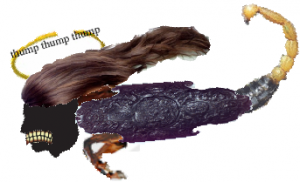 John.
John.
Compiling together all the previous features (locusts, scorpions, horses, crowns, faces, hair, teeth) of this insect, John notes they also possess armor plating. Their strange sounding “wings” (“on top of their heads”?) like furiously galloping horses is another prominent feature.
Fixed “wings” on ordinary aircraft make very little if any “sound.” Since on “their heads were as it were crowns like gold” (Verse 7), we can assume that is where their noisy “wings” are located, strongly suggesting them to be rotary wings that look like a halo or a “crown” while in rotation.
But there’s more:
Verse 10: And they had tails like unto scorpions, and there were stings in their tails: and their power was to hurt men five months.
In Verse 3 they had “power, as scorpions,” here they have “tails” similar to that insect. Taking into consideration all the features John used to describe this creature, its likeness to the features of a helicopter is compelling. Nevertheless, we can only guess how they are able to sting with their “tails” because the tail rotor of a helicopter is essential for maintaining control in flight and cannot be used as a weapon. However, who knows what today’s technology will create? ―certainly nothing John could have imagined. It was not until 1942 that a helicopter reached full-scale production and would come to be recognized worldwide as the helicopter. [37] Exactly how they will be able to “hurt,” without killing, would be speculative at this time, neither is it important to know. However, when the attack actually begins, those who are familiar with this prophecy will have no difficulty understanding that it is being fulfilled and know that the attack will last exactly “five [literal] months.” [38]
This is not “time setting” [39] because it is impossible, now, to establish a date for the beginning of the “five months.” Not knowing when Jesus will throw down the censer, not knowing how long the first, second, third and fourth trumpet scenarios will last, we will only be able to know how long the fifth trumpet will last, but still not know when it will begin. So, at this point in history, the “five months” is only “indefinite time.” [40] It will become “definite” only when the attack begins.
Verse 11: And they had a king over them, which is the angel of the bottomless pit, whose name in the Hebrew tongue is Abaddon, but in the Greek tongue hath his name Apollyon.
This “king” is the “star” John saw “fall from heaven unto the earth” (Verse 1),” referencing the war in heaven when Satan and his angels were cast out (Revelation 12:7-9). Evidently, John gave both the Hebrew and Greek names to this “king . . . which is [an] angel” to highlight his supernatural nature both to the Greek as well as the Hebrew reader. Therefore, if this “king” is supernatural, he could not be “Osman (Othman) I, (1299-1326), the traditional founder of the Ottoman Empire,” an identity many have ascribed to him. [41]
Be-that-as-it-may, whether in the “Hebrew” or “Greek” tongues, the name of the “king” means: “destruction, ruin, the minister of death, the author of havoc on the earth, the destroyer.” [42] This is the rider of the “pale horse” whose “name that sat on him was Death, and Hell followed with him. And power was given unto them over the fourth part of the earth, to kill with sword, and with hunger, and with death, and with the beasts of the earth” (Revelation 6:8).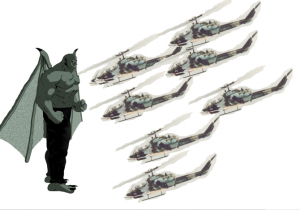
As we have learned, “Wormwood,” the “great star” who also “fell . . . from heaven, burning as it were a lamp” to dazzle the eye of the spiritually gullible, took pleasure in contaminating “the third part of the rivers, and . . . the fountains of waters” to cause “many men” to die “of the waters, because they were made bitter” (Revelation 8:10, 11). [43] Even though “Wormwood” disguised himself as Christ, he was still engaged in his favorite sport, killing as many people as he could without blowing his disguise.
Few will argue that Satan is multitalented. He has extraordinary ability to deceive. In this case he modifies his deception to suit the philosophy of his victims. As Wormwood, professed Christians are an easy mark. As Abaddon, the avowed unbeliever is readily deceived by his power to destroy and intimidate. This should be “no marvel; for Satan himself is transformed into an angel of light” (2 Corinthians 11:14), or as “the angel of the bottomless pit.”
But why does he torment those who have the mark of the beast [44] for “five” excruciating “months?” What does he hope to gain? The next ten verses give a pretty good explanation.
Verse 12: One woe is past; and, behold, there come two woes more hereafter.
In other words, the “five months,” twice mentioned (Verses 5, 10), during which the tormenting “locusts” had a field day, have expired. Obviously, the “men” who sought “death, and shall not find it” (Verse 6), are hopping mad and will now look for ways to avenge themselves and make sure it doesn’t happen again.
In order to understand what this “one woe” is, the Commentary suggests, we go back to Revelation 8:13. [45] There, John “heard . . . a loud voice” saying “Woe, woe, woe, to the inhabiters of the earth by reason of the other voices of the trumpet of the three angels, which are yet to sound!” This announcement is made in the context of the “the fourth angel” (or fourth trumpet) of Verse 12. Therefore, this “one woe” that is now “past,” is the first “woe” or fifth trumpet scenario (Revelation 9:1-11). The “two woes more hereafter” are the sixth trumpet (the “second woe”) and seventh trumpet (the “third woe”).
As noted before, going back to the book of Daniel, we see that “at the time of the end shall the king of the south push at him” (Daniel 11:40), with the word “push” [46] denoting something like a goad which only torments without killing, which is what happened in the first woe.
Verse 13: And the sixth angel sounded, and I heard a voice from the four horns of the golden altar which is before God,
This is not “the sixth angel” of Revelation 16:12 which has a “vial” that he pours “out.” Instead, this “angel sounded” his trumpet. Therefore, his sounding is the warning of the “second woe” that, surprisingly, is not mentioned again until its ending (Revelation 11:14). Nevertheless, we can be certain that the “sixth angel” is the “second” of the three “woes” of Revelation 8:13.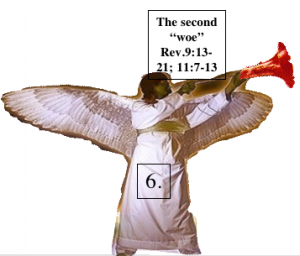
When he “sounded,” John hears this “voice” that comes “from the four horns of the golden altar which is before God,” the same “golden altar which was before the throne” (Revelation 8:3) in the “first apartment” [47] of the heavenly sanctuary, upon which Jesus had offered the “incense.”
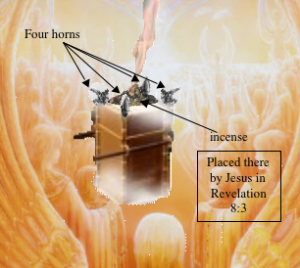 The incense must still be giving off its fragrance in this scene, while a voice is heard coming from the altar’s “four horns.” Consequently, while the “incense” represents the sustaining grace of God’s mercy on behalf of the righteous during this post probationary scenario of the seven trumpets, His having cast the censor to the earth, suggests His work at the altar is finished and there is no longer atonement for the sinner.
The incense must still be giving off its fragrance in this scene, while a voice is heard coming from the altar’s “four horns.” Consequently, while the “incense” represents the sustaining grace of God’s mercy on behalf of the righteous during this post probationary scenario of the seven trumpets, His having cast the censor to the earth, suggests His work at the altar is finished and there is no longer atonement for the sinner.
According to the Old Testament, both altars (the altar of burnt offering in the courtyard, and the altar of incense in the first apartment) in the earthly sanctuary had horns mounted on each of their four corners (Exodus 27:2; 30:1-5). In part of the ritual for the sin of ignorance, in which a bullock was slain, “the priest . . . put some of the blood upon the horns of the altar of sweet incense . . .” (Exodus 30:10) signifying atonement had been made. When “Adonijah feared because of Solomon, [he] arose, and went, and caught hold on the horns of the altar” and plead: “Let king Solomon swear . . . that he will not slay his servant with the sword.” Joab did the same thing, fleeing “unto the tabernacle of the LORD, and caught hold on the horns of the altar” (1 Kings 1:50, 51; 2:28). Zechariah saw “four horns” and asked “what be these?” The answer was “These are the horns which have scattered Judah, Israel, and Jerusalem” (Zechariah 1:18,19).
Placing blood on the horns signifies that the blood of Christ has satisfied justice. Adonijah and Joab’s clinging to the horns must represent a desperate plea for mercy and staying the hand of justice. The “four horns” of Zechariah represent “the powers” [48] that defeated his nation, which God allowed in His ministration of justice.
The “voice” of Jesus coming “from the four horns,” with no more blood or incense [49] being administered, must represent the fact that mercy has been withdrawn and justice, unmixed with mercy, is being meted out, the same concept represented by “the censer” being “filled” entirely “with fire of the altar, and cast . . . into the earth” (Revelation 8:5).
Verse 14: Saying to the sixth angel which had the trumpet, Loose the four angels which are bound in the great river Euphrates.
Who are these “four angels?” They cannot be the “four angels” of Revelation 7:1, because they were restraining the “four winds,” while these, up to the time of the sixth trumpet, had been “bound,” or restrained. Since it is probably the voice of Jesus being heard speaking through the four horns, He now gives permission for the release of the “four angels” which, previously, had been “bound.” [50]
This verse introduces another symbol: “the great river Euphrates.” It is seen again in the context of the seven last plague scenario (Revelation 16:12). Since most of us agree that the seven last plagues are a series of future, end-time catastrophes, it stands to reason this is the same parallel figure, even though in the context of the sixth trumpet. Nevertheless, whatever it represents in Revelation 16, it must be figurative of the same thing in this post probationary sixth trumpet setting.
One of the interpretations alluded to in the Commentary is: “. . . inasmuch as later in the Revelation the final apostasy is portrayed as mystic Babylon (ch. 17:5) and that particular attention is called to its sitting ‘upon many waters’ (v. 1), and inasmuch as historical Babylon was literally situated upon the waters of the Euphrates, the Euphrates is here symbolic of the domain of the power represented as mystic Babylon.” [51] In our view, it would be Wormwood’s domain, represented by “the horse that was red” whose rider was “was given . . . a great sword” “to take peace from the earth, and that they should kill one another” (Revelation 6:4) ―or the “synagogue of Satan” (Revelation 2:9 and 3:9).
Euphrates, the Euphrates is here symbolic of the domain of the power represented as mystic Babylon.” [51] In our view, it would be Wormwood’s domain, represented by “the horse that was red” whose rider was “was given . . . a great sword” “to take peace from the earth, and that they should kill one another” (Revelation 6:4) ―or the “synagogue of Satan” (Revelation 2:9 and 3:9).
Like the “four winds of the earth” (Revelation 7:1), that had to be restrained to prevent damage to the earth, sea and trees, these “four angels” also had to be restrained for some time before the appropriate hour of their release. These “four angels” are not at all God’s angels, as the next few verses will show. They are angry, evil angels straining at the leash to wreck ruin and desolation. The obvious reason for their anger (although there is at least one more) is the “torment” they had to endure for five, long months during the time of the fifth trumpet/first woe.
As we saw in that first “woe,” the locusts really represent Satan’s human agents dedicated to carrying out his will. Likewise, these “four angels” must also be representative of his human agents devoted to Satan’s agenda and are a subset of the domain of mystic Babylon, representing a significant number of those within her domain who are eager for retaliation against Abaddon’s locust attack (Verses 1 to 11). We can also assume that the majority of that domain were reluctant to wage war, until struck by the torment of the fifth trumpet. Now, they are more than ready for those “four angels” to wage war and to retaliate.
Consequently, these “four angels” must represent the military might of Wormwood’s domain that has, up to this moment, been kept back from doing what it was designed to do, which is to destroy, in contrast to the “four angels” of Revelation 7:1-3 who are striving to protect the “earth, sea,” and “trees.”
Verse 15: And the four angels were loosed, which were prepared for an hour, and a day, and a month, and a year, for to slay the third part of men.
So, they are “loosed” by popular demand of the people, or the “domain” of “Wormwood,” represented by “the great river Euphrates.” They had just endured “five months” of “torment” afflicted by the “locusts” (Verses 5-10). Therefore, this loosening is motivated by revenge. It is retaliation against the five-month period of abuse Wormwood’s domain had just suffered at the hand of the “king” over the locusts “whose name in the Hebrew tongue is Abaddon” (Revelation 9:11).
 At this point, like the “five months” (Verses 5, 10), we come to another time prophecy, the “hour . . . day . . . month . . . year.” Clearly, it must have some relationship to the “five months.” From the historic perspective, all time periods are based on the “day-year” principle. According to Maxwell: “On this basis, a year of twelve thirty-day months represents 360 years. When we add 1 year plus 30 years plus 360 years, we get 391 years.” [52]
At this point, like the “five months” (Verses 5, 10), we come to another time prophecy, the “hour . . . day . . . month . . . year.” Clearly, it must have some relationship to the “five months.” From the historic perspective, all time periods are based on the “day-year” principle. According to Maxwell: “On this basis, a year of twelve thirty-day months represents 360 years. When we add 1 year plus 30 years plus 360 years, we get 391 years.” [52]
Josiah Litch, using the same calculations, “published an exposition of Revelation 9, predicting the fall of the Ottoman empire . . . on the 11th of August, 1840 . . .” [53] It worked out remarkably well when “At the very time specified, Turkey . . . accepted the protection of the allied powers of Europe” which was “the event [that] exactly fulfilled the prediction.” [54]
Even though Litch seemed to have it all together, he overlooked the fact that the “men” who suffered for those “five months” could not have lived for 150 years, let alone 391 years, and to endure such agony that they wished “to die, and death shall flee from them” (Verse 6). Neither will “those men which have . . . the seal of God in their foreheads” (Verse 4) have to live another 391 years on the earth before being translated.
Consequently, there are real problems with the historic application, which highlights the Commentary’s final statement: “It should be made clear . . . that commentators and theologians in general have been greatly divided over the meaning of the [fifth and sixth] trumpets” [55], and do not allude to the possibility that they might denote future events. Much of this confusion would have been avoided had we believed what the Lord’s servant said many years ago in 1890: “The battle of Armageddon will be fought, and that day must find none of us sleeping. Wide-awake we must be, as wise virgins having oil in our vessels with our lamps. What is this? Grace, Grace.
“The power of the Holy Ghost must be upon us, and the Captain of the Lord’s host will stand at the head of the angels of heaven to direct the battle. Solemn events before us are yet to transpire. Trumpet after trumpet is to be sounded, vial after vial poured out one after another upon the inhabitants of the earth.
“Scenes of stupendous interest are right upon us, and these things will be sure indications of the presence of Him who has directed in every aggressive movement, who has accompanied the march of His cause through all the ages, and who has graciously pledged Himself to be with His people in all their conflicts to the end of the world. He will vindicate His truth. He will cause it to triumph. He is ready to supply His faithful ones with motives and power of purpose, inspiring them with hope and courage and valor in increased activity as the time is at hand.” [56]
That statement is obviously inclusive of the 5th and 6th trumpets.
What then, do we do with the “hour . . . day . . . month . . . year” time prophecy? Even though Maxwell opposes it, he alludes to some “modern versions” that “translate the passage, ‘the hour, the day, the months, and the year’ making it refer to a specific point of time rather than to an extended period of time.” [57] Although he makes a good case for the historic view, it would again be impossible to support a 391-year time period for the biblically authentic future view. Therefore, a “specific point in time” makes good sense for the future view.
But what “specific point of time” could John be referring to? Quite likely, it was something that happened before the “five months” (Verses 5, 10) because the “four angels” had been restrained throughout that time and had been eager to set things straight with their enemies in the pale horse camp.
That egregious event could well be the time when “the second angel sounded, and as it were a great mountain burning with fire was cast into the sea: and the third part of the sea became blood: and the third part of the creatures which were in the sea, and had life, died; and the third part of the ships were destroyed” (Revelation 8:8, 9). Such a cataclysm would happen suddenly, almost instantaneously on a certain “hour,” on a certain “day,” of a certain “month,” during a certain “year” [58] in the future. Even though it is impossible to set a date for that event prospectively, when it does take place―like REMEMBER PEARL HARBOR on 12-7-41 or DON’T FORGET NYC on 9-11-01―none who are alive at the time it occurs will ever forget it! Both of these historical events infuriated the populace who cried for vengeance. The same principal, coupled with a five-month period of torment, would fan the victims’ feelings of resentment to a white heat.
Verse 16: And the number of the army of the horsemen were two hundred thousand thousand: and I heard the number of them.
Here, for the first time, the antagonist of the “locusts” (Verses 3-10) is introduced. It is an enormous, ground based “army of . . . horsemen” riding (according to Verse 17) horses, which at first glance, even though their numbers are vast, would be a poor match against the “locusts” (Verses 3-10).
As the Commentary declares, this number amounts to “two hundred million,” suggesting it “is doubtless symbolic of a vast, innumerable host.” [59] But, according to what John says, he actually “heard the number of them,” possibly from the “voice from the four horns” (Verse 13). That suggests the number is literal. Note, that “the four angels . . . were prepared” (Verse 15) [60], or had been preparing, for this “hour” for some time by now and had marshaled this great “army of horsemen” for the purpose of retaliating against those responsible for the “burning” of the “great [symbolic] mountain” that was cast into the sea (Revelation 8:8). The “five months” torment only made them more determined than ever to carry out their plans.
Therefore, it seems clear the “number of the horsemen” is not a disorganized, “numberless throng” [61] or an ill-defined mob, rather it must be a carefully planned, well organized “army of horsemen” who understand their mission.
Verse 17: And thus I saw the horses in the vision, and them that sat on them, having breastplates of fire, and of jacinth, and brimstone: and the heads of the horses were as the heads of lions; and out of their mouths issued fire and smoke and brimstone.
With all due respect to the traditional understanding, this verse and the following make it abundantly clear these are no ordinary horses. The mechanical beasts in the science fiction movie Empire Strikes Back may have come closer than anyone else in depicting what these horses may look like.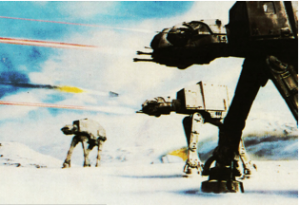
While the strange “locusts” (Verses 3-10) who possess the power of “scorpions” and have “wings” which sound like “horses” going into battle,” plus having “tails like scorpions,” can easily be likened to the helicopters of our day, these last day “horses” strain the imagination for they are far stranger than the “locusts.”
Note that the “breastplates” of the riders, are not like the “breastplates of iron” like the “locusts” (Verse 9), but of “fire, jacinth and brimstone!” While the “shapes of the locusts were like unto horses” (Verse 7), the “heads” of these horses looked like “the heads of lions” and their “tails” even “had heads” (Verse 19)! The “breastplates” are seen as some kind of armor plating to protect the riders of these horses, and the difficulty in picturing what John saw does not lie only in the camp of those who see this as a future development, but also for those who see this from the historic perspective.
In the historical interpretation, instead of “fire and smoke and brimstone” actually issuing “out of their mouths,” it must be interpreted as an optical illusion that only appears, “from a distance,” to be seen as “fire coming out of the horse’s mouth” [62], while John clearly says it “issued” “out of their mouths.”
Verse 18: By these three was the third part of men killed, by the fire, and by the smoke, and by the brimstone, which issued out of their mouths.
Note how John repeats what he relates in Verse 17, saying again, “the smoke, and . . . brimstone . . . issued out of their mouths” as if he were concerned that we would not believe what he said and yield to the temptation to put a twist on it. We can all agree that what comes out of their mouths is definitely lethal, because “the third part of men [are literally] killed by” these three― “the fire . . . the smoke, and . . . the brimstone.” This is in contrast to the attack of the “locusts” which only “torment” or torture for “five months,” while the horsemen’s counterattack is dreadfully lethal, killing “the third part of men,” which leaves us wondering why “the third part,” and who are these “men” that are “killed”?
The “tail” of the “great red dragon . . . drew the third part of the stars of heaven, and did cast them to the earth” (Revelation 12:3, 4, 7). Those “stars” represent a “third part” of the angels in heaven who chose to side with Lucifer in that great “war” between “Michael and his angels” and “the dragon . . . and his angels.” Therefore, it seems, “the third part” is representative of those of whom Satan has dominion, whether of angels, men, or even “the third part of [the] trees . . . sea . . . ships . . . rivers . . .waters . . . sun . . . moon . . . stars . . . day” even “the night” (Revelation 8:7-12), most of which are “hurt” or destroyed by Satan during the first, second, third and fourth trumpet scenarios. While the “fifth” trumpet or “first woe” falls on all who “have not the seal of God in their foreheads” (Verse 4), the “sixth trumpet,” or “second woe” falls only upon “the third part of men.”
If we allow the pitched battle between the kings of the “north” and “south” (Daniel 11:40) to be the parallel to the pitched battle between the “locust” perpetrators and the army of “horses,” it becomes clear that the “push” by “the king of the south” is equivalent to the nonfatal “torment” of the “locusts” against those “who have not the seal of God in their foreheads,” and by deduction, those who have the “mark of the beast.” Then, just as “the king of the north,” who comes “against” the king of the south “like a whirlwind,” these strange horses come against the “locusts . . . men” with greater ferocity.
The parallels to Daniel’s kings of the “north” and “south,” both of which represent the servants of Satan, are John’s “red” and “pale” horses (Revelation 6:4, 8) which are controlled by their respective riders, that “take peace from the earth” and “kill one another,” the “red horse” rider with the “great sword,” and the “sword . . . hunger . . . death, and . . . beasts of the earth” of the “pale horse” whose rider is “Death.” Taking Daniel 11:40 as the template for the scenario of Revelation 9, the “locusts” must be represented by the southern “pale horse” under the command of “Abaddon,” and the strange, fire breathing horses by the northern “red horse” under the command of “Wormwood.” Therefore, the “third part of men,” who were “killed,” must be represented by the “pale horse” whose rider is “Death.” Consequently, they will have been betrayed by “Abaddon” who “commanded [his pale horse people] that . . . they should not kill” any of the red horse people under Wormwood’s command, only torment them for “five months.”
Verse 19: For their power is in their mouth, and in their tails: for their tails were like unto serpents, and had heads, and with them they do hurt.
Once again, as he did in Verses 17 and 18, John emphatically states that “their power (represented by ‘the fire . . . the smoke, and . . . the brimstone’)” is really “in their mouth.” No literal horses, either of the past or in the future, have such “power.” Therefore, these must be figurative horses. Even though John saw things that bore a likeness to “horsemen” and “horses,” they must be some of the “deadly instruments of warfare that will be invented.” [63] He then describes something stranger yet: that “their power” is also “in their tails.” But, instead of “tails like unto scorpions,” with which the scorpion-like “locusts” could hurt, these are “like unto serpents.” Still more unusual, “their tails . . . had heads” instead of “stings,” and “with them they do hurt.” Therefore, these are some sort of two headed “instruments of warfare!”
As can be expected, the strange detail about the horses’ “tails” is very difficult to deal with from the historic perspective. Although the Commentary acknowledges: “These horses wreak havoc both with their heads and with their tails,” it says nothing about the “tails” having “heads” and only refers to “certain expositors [who] see in these ‘tails’ a reference to a horse’s tail as a Turkish standard.” [64] But, a “standard” is only a sign or a flag and cannot be used to “wreak havoc.”
The future application is also difficult because no such “instrument of warfare” has yet been invented (that we know of), although, technically speaking, the construction of such an article of warfare is possible. And, unlike the “locusts,” which are flying machines, these “horses” will be ground based vehicles. [65] At this point, we must leave it alone and wait and see. Whatever they are, John’s description will suffice enabling the believers in prophecy to identify where we are in the trumpet scenario and know, without question, what is to come.
“But while anguish was upon the loyal and true, who would not worship the beast or his image and accept and revere an idol sabbath, One said, ‘Look up! Look up!’ Every eye was lifted, and the heavens seemed to part as a scroll when it is rolled together, and, as Stephen looked into the heaven, we looked. The mockers were taunting and reviling us and boasting of what they intended to do to us if we continued obstinate in holding fast our faith. But now we were as those who heard them not. We were gazing upon a scene that shut out everything else.” [66]
Will knowledge of the trumpets have a part to play in enabling the saints to “Look up!” during the time of Jacob’s trouble? Absolutely!
Verses 20, 21: And the rest of the men which were not killed by these plagues yet repented not of the works of their hands, that they should not worship devils, and idols of gold, and silver, and brass, and stone, and of wood: which neither can see, nor hear, nor walk: Neither repented they of their murders, nor of their sorceries, nor of their fornication, nor of their thefts.
The “rest of the men” are the survivors, unlike “a third part of their” fellows who were “killed” by “these plagues.” Those “plagues” are identified as “the fire . . . the smoke, and . . . the brimstone” coming out of the “mouths” of the “horses” (Verse 18).
The obdurate nature of these surviving “men” who “repented not” is much like “that woman Jezebel” who also “repented not” in spite of being given “space 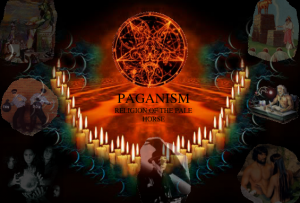 to repent . . .” of her deeds and teachings which were “to commit fornication, and to eat things sacrificed unto idols” (Revelation 2:20, 21). Consequently, this verse depicts the paganistic religion of the “men” who operated the scorpion-like “locusts” (Verses 3-10) whose “king was “Abaddon” or “Apollyon,” the satanic “destroyer,” the rider of the “pale horse” whose name was “Death” (Revelation 9:11; 6:8).
to repent . . .” of her deeds and teachings which were “to commit fornication, and to eat things sacrificed unto idols” (Revelation 2:20, 21). Consequently, this verse depicts the paganistic religion of the “men” who operated the scorpion-like “locusts” (Verses 3-10) whose “king was “Abaddon” or “Apollyon,” the satanic “destroyer,” the rider of the “pale horse” whose name was “Death” (Revelation 9:11; 6:8).
Interestingly, one would think they would now have become extremely resentful of Abaddon for commanding them “not to kill” the “men which have not the seal of God in their foreheads.” Whether it was loyalty that kept them from repenting, or that they were so intimidated by Abaddon that they could not, is a detail yet to be explained. But one thing is clearly suggested: this assault of the armies of Wormwood, the false Christ, against the armies of Abaddon, will be like a last day Crusade, much like that which took place in the twelfth century A.D. and briefly referred to in Daniel 11:25 where the “vile person” stirred “up his power and courage against the king of the south with a great army.”
These verses depict the “men” who are defeated in this battle, with nothing said about the victors. But the sixth trumpet scenario does not end here! The conclusion to the sixth trumpet scenario is found two chapters later (Revelation 11:7-13) where great rejoicing is followed by the bitter disappointment represented by Satan’s name, “Wormwood.” That will be the bitter, up-and-down experience of those who are duped by Wormwood! an experience even more terrible than that of the defeated, unrepentant “men” who were duped by Abaddon.
Summary of chapter 9: The subject of this chapter concerns the events of the fifth and sixth trumpet scenarios, that are the first two (Revelation 8:13) of the three woes “which are yet to sound.” John spends considerable time describing the features of the unusual locusts (Verses 3-10) and the strange horses (Verses 17-19), suggesting they represent last day, military implements of warfare. But whatever they are, it is obvious that God is not responsible for these weapons. The “angel of the bottomless pit,” named “Abaddon” or “Apollyon,” who received the key to the bottomless pit from God, is the responsible agent for the five-month period of torture in the first woe and the horrible slaughter of the second woe. Obviously, it is Satan who is in control as the commander of the locusts, as well as the horses. He, named Abaddon of the locusts and, by process of deduction, named Wormwood as the commander of the horses, is the one who will engage them in that final, last day pitched battle of all time. Although, not generally recognized, the last part of the sixth trumpet/second woe scenario, is found in Chapter 11, Verses 7-13.
[1] Even though the statement in The Great Controversy, dealing with Josiah Litch’s exposition of Revelation 9 (see The Great Controversy pages 334, 335), deals only with this chapter, with nothing about the first four trumpets in Chapter 8, the assumption is they must also be historic, regardless of the context both in Chapters 7 and 8 which place them in the future.
[2] An example of that is found in the sixth trumpet scenario of Revelation 6:12 to 7:17, where there are several prospective jumps ahead, followed by retrospective segments. Note the prospective jump between the historic events of Verses 12 and 13, followed by the prospective look at the second coming in Verses 14 to 17. Then the scenario falls back to the present time of the four angels of Revelation 7:1-3 who are protecting the earth, sea and trees until God’s servants are sealed, then a jump ahead to the “great tribulation” in Verse 14, ending with the reward of the righteous, even further into the future, in Verses 15 to 17.
[3] The Great Controversy by E.G. White, pages 334, 335 (italics supplied)
[4] Last Day Events by E.G. White, page 238; 1888 Materials by E.G. White, page 762; Manuscript Releases by E.G. White, Vol .14, page 287; Seventh-day Adventist Bible Commentary, Vol. 7, page 982; Selected Messages by E.G. White, Vol. 3, page 426; Maranatha by E.G. White, page 257
[5] “The Bible is its own expositor. Scripture is to be compared with scripture. The student should learn to view the word as a whole and to see the relation of its parts. He should gain a knowledge of its grand central theme―of God’s original purpose for the world, of the rise of the great controversy, and of the work of redemption. He should understand the nature of the two principles that are contending for the supremacy, and should learn to trace their working through the records of history and prophecy to the great consummation. He should see how this controversy enters into every phase of human experience; how in every act of life he himself reveals the one or the other of the two antagonistic motives; and how, whether he will or not, he is even now deciding upon which side of the controversy he will be found.” (Counsels to Parents, Teachers, and Students page 462)
[6] The Great Controversy pages 334, 335 (italics supplied)
[7] Selected Messages by E.G. White, Vol. 3, Appendix 3, page 452
[8] Manuscript Releases by E.G. White, Vol. 14 page 283 (the “trumpet after trumpet” statement is on page 287)
[9] Ellen G. White Volume 2 The Progressive Years 1862-1876 page 81 by Arthur L. White
[10] See God Cares by Mervyn Maxwell, Vol. 2, page 243
[11] Note in Verse 12 of this chapter: “One woe is past.” That “one woe” must be the “first woe” scenario of the previous 11 verses. See also Daniel and the Revelation by Uriah Smith, page 491.
[12] See Revelation of Jesus Christ by Ranko Stefanovic, page 300
[13] Strong’s #3, “a destroying angel”
[14] Mervyn Maxwell even though speaking from the historic perspective, agrees that “’Abaddon,’ ‘Apollyon,’ and ‘Destroyer’ —is obviously Satan . . .” (God Cares by Mervyn Maxwell, Vol. 2, pages 243, 250)
[15] Note again: “Abaddon” (Strong’s #3) “destroying angel.” Thayer’s definition: “ruin, destruction, the place of destruction,” or “the name of the angel-prince of the infernal regions, the minister of death and author of havoc on the earth.” “Apollyon” (Strong’s #623) “destroyer (that is Satan).” Thayer’s definition: “the angel of the bottomless pit, the Destroyer”
[16] The “bottomless pit” is a metaphor only found in the book of Revelation. All literal “pits” have bottoms allowing for the possibility of rescue. Absence of a “bottom,” suggests absence of any chance for rescue. Therefore, “the bottomless pit” must be a metaphor for post probationary time, another factor obliging us to apply the “fifth” trumpet scenario to the future.
[17] Explanations offered in the Commentary are: “it represents the sea in general,” or the “depths of the earth. . . . With respect to the Arabs, the bottomless pit may be thought of as representing the vast wastes of the Arabian deserts . . .” (Seventh-day Adventist Bible Commentary, Vol. 7, page 791 [top right column]) See also, Daniel and the Revelation by Uriah Smith, page 496, 497.
[18] Seventh-day Adventist Bible Commentary, Vol. 7, page 791 (right column under “Darkened.”)
[19] The entire statement is found in Manuscript Releases by E.G. White, Vol. 9, pages 7 and 8: “Revelation is a sealed book, but it is also an opened book. It records marvelous events that are to take place in the last days of this earth’s history. The teachings of this book are definite, not mystical and unintelligible. In it the same line of prophecy is taken up as in Daniel. Some prophecies God has repeated, thus showing that importance must be given to them. The Lord does not repeat things that are of no great consequence.” ―Manuscript 107, 1897, pp. 1,2. (“Search the Scriptures,” no date.)
[20] Seventh-day Adventist Bible Commentary, Vol. 7, page 791 (right column under: “3. Locusts.”)
[21] Ibid. Although the Commentary logically applies these features to literal men, unfortunately, it fails to draw attention to the sealed people in Chapter 7, depicting their sealing which takes place just before the close of probation.
[22] 1888 Materials by E.G. White, page 701; Manuscript Releases by E.G. White, Vol. 15, page 15; Seventh-day Adventist Bible Commentary, Vol. 7, page 976; Maranatha by E.G. White, page 164
[23] as well as the third and fourth trumpets as we read in Revelation 8:7-14.
[24] Seventh-day Adventist Bible Commentary, Vol. 7, page 792 (left column under: “5. Should not kill.”)
[25] Difficult, at least, for conservative Seventh-day Adventists who hold to the rigid application of prophetic time post 1844.
[26] “A great work can be done by presenting to the people the Bible just as it reads. Carry the word of God to every man’s door, urge its plain statements upon every man’s conscience, repeat to all the Saviour’s command: ‘Search the Scriptures.’ Admonish them to take the Bible as it is, to implore divine enlightenment, and then, when the light shines, to gladly accept each precious ray and fearlessly abide the consequences.” (Testimonies for the Church by E.G. White, Vol. 5, page 388; The Publishing Ministry, by E.G. White, page 283)
[27] Counsels to Parents, Teachers and Students, by E.G. White, page 462, and many other references
[28] “months” translated from: “men” (Strong’s #3376) “a month, the time of the new moon, new moon (the first day of each month, when the new moon appeared was a festival among the Hebrews) found 19 times in the NT in Luke 1:24, 26, 36, 56; 4:25; Acts 7:20; 18:11; 19:8; 20:3; 28:11; Galatians 4:10; James 5:17 besides in the book of Revelation.
[29] Seventh-day Adventist Bible Commentary, Vol. 7, page 795 (left column first paragraph)
[30] Acts of the Apostles by E.G. White, page 585
[31] “push” from the Hithpael of “nagach” (Strong’s #5055) “to engage in thrusting, wage war”
[32] This is jumping ahead into Revelation 13:16, 17: 14:9, 11; 15:2; 16:2; 19:20 and 20:4 where the “mark” is mentioned eight times. However, all who do not receive “the seal of God in their foreheads” will almost automatically, it appears, receive the “mark of the beast” either in their foreheads or in their hands (see Revelation 13:16; 14:9 & 20:4)
[33] “It may be innocent to speculate beyond what God’s word has revealed, if our theories do not contradict facts found in the Scriptures . . .” (Patriarchs and Prophets, page 113 fourth paragraph) I do not believe any of this speculation is contrary to God’s word.
[34] Professed Christians, depicted in Revelation 2:9 and 3:9, are identified as “them which say they are Jews, and are not.” They belong to “the synagogue of Satan.” They come under the control of “him that sat” on the “horse that was red:” They “take peace from the earth, and . . . kill one another.” (Revelation 6:4)
[35] These people come under the control of him “that sat on” “a pale horse.” His name “was Death, and Hell followed with him.” (see Revelation 6:8)
[36] Although also named “Apollyon,” both names designate the same person, Satan.
[37] http://en.wikipedia.org/wiki/Helicopter
[38] See our discussion of the literalness of the “five months” in Verse 5.
[39] There are about 19 references where White specifically warns against “time setting.” For example, see Selected Messages by E.G. White, Vol. 1, pages 145, 188, Vol. 2, page 62; 1888 Materials by E.G. White, page 499; Last Day Events by E.G. White, page 34; Manuscript Releases by E.G. White, Vol. 14 page 190; Seventh-day Adventist Bible Commentary, Vol. 6, page 1052 etc.
[40] White used the term “definite time” more than eighty times. For example, refer to Manuscript Releases by E.G. White, Vol. 1, page 100, Vol. 10 page 268, Vol. 16, page 177, Vol. 19 page 320; The Great Controversy by E.G. White, pages 370, 456, 457; Seventh-day Adventist Bible Commentary, Vol. 7, page 971, Early Writings by E.G. White, page 233, and etc. Therefore, any time period that transpires after 1844 should be regarded as “indefinite time.”
[41] Seventh-day Adventist Bible Commentary, Vol. 7, page 792 (right column under: “11. King over them.”)
[42] See note [15].
[43] While the “waters” could be symbolic of Satan’s false doctrine, the doctrine of the “synagogue of Satan” (Revelation 2:9, 3:9), by virtue of them being a portion, a “third” suggests they may also be literal. Plenty of room for discussion and differences of opinion!
[44] As noted in our discussion of Verse 4, those who were “hurt,” had to be those who had the “mark of the beast” because anybody alive, after the close of probation, will either have the seal of God or the mark of the beast. Also, as noted, those under the command of Abaddon, because they consider Wormwood” the false Christ, to be a fraud, will possibly renounce the “mark” at the time of the fourth trumpet, or at least have a mark only in their hand. (Revelation 8:12).
[45] Seventh-day Adventist Bible Commentary, Vol. 7, page 792 (right column under “12. Woe.”) “See on ch. 8:13.”
[46] “push” from “nagach” Strong’s #5055, a primitive root; TWOT – 1291; v. KJV – push 8, gore 3; 11. 1) to push, thrust, gore, 1a) (Qal) to gore, 1b) (Piel) to push or thrust at, 1c) (Hithpael) to engage in thrusting, wage war.
[47] See Great Controversy by E.G. White, page 414 and Patriarchs and Prophets by E.G. White, page 356
[48] see Prophets and Kings by E.G. White, page 581
[49] Remember that Jesus had already placed “incense . . . upon the golden altar” in Revelation 8:3, representing the sustaining grace of God throughout the post probationary time of Jacob’s trouble. Thus, we can assume it is still present here.
[50] The Greek word for “bound” is interesting. It is from: “dew” or “deo deh’-o” (Strong’s #1210) meaning: (1) find tie, fasten (1a) to find, fasten with chains, to throw into chains (1b) metaphorically: (1b1) Satan is said to bind a woman bent together by means of a demon, as his messenger, taking possession of the woman and preventing her from standing upright (1b2) to bind, put under obligation, of the law, duty etc. (1b2a) to be found to one, a wife, a husband (1b3) to forbid, prohibit, declare to be illicit.
[51] Seventh-day Adventist Bible Commentary, Vol. 7, page 793 (bottom left column to top of right)
[52] God Cares by Mervyn Maxwell, Vol. 2, bottom of page 255
[53] But we need to forgive Litch and the others for their assumption, because, as William Miller proposed, the end of the 2300 years of Daniel 8:14 was supposed to be the end of the world. Therefore, from their perspective, the scenario of the fifth and sixth trumpets had to be historic. It would have been impossible for them to conceive of a future application. Anything that contradicted that presupposition was, of necessity, ignored. So, we can forgive them, but how about us? It seems that we are perpetuating their misconception.
[54] See Great Controversy by E.G. White, page 334, 335
[55] Seventh-day Adventist Bible Commentary, Vol. 7, page 796 (top of page, left column) They attribute the difficulty “principally to problems in three areas: (1) the meaning of the symbolism itself; (2) the meaning of the Greek; (3) the historical events and dates involved.” No remark is made about the possibility of future fulfillment.
[56] Manuscript Releases by E.G. White, Vol. 14, page 287 (italics supplied for emphasis); found also in 1888 Materials by E.G. White, page 762; Seventh-day Adventist Bible Commentary, Vol. 7, page 982; Selected Messages by E.G. White, Vol. 3, page 426; Maranatha by E.G. White, page 257; Last Day Events by E.G. White, page 238
[57] God Cares by Mervyn Maxwell, Vol. 2, page 256 (top of page)
[58] The “an hour, and a day, and a month, and a year” has long been interpreted as prophetic time amounting to 391 years plus 15 days of literal time. Such application, especially when added to “five months” (or 150 years) of prophetic time would bring the total to more than 541 years of literal time. Such a lengthy span of time can only be applied to history, but impossible to apply to time after God’s servants have been sealed in their foreheads, the “four winds of the earth” are released and Jesus casts “the censer into the earth.” Several generations of sealed servants would have to live and die throughout post probationary time, which is unconceivable.
[59] Seventh-day Adventist Bible Commentary, Vol. 7, page 793 (under “Two hundred thousand thousand.”)
[60] “prepared” from: “hetiomazo” (Strog’s #2092) “to make ready, prepare, to make the necessary preparations, get everything ready.”
[61] According to the Commentary: “The syntax of this statement in Greek may imply that John heard this number and understood its significance. Oral information confirmed his impression of a numberless throng.” (Seventh-day Adventist Bible Commentary, Vol. 7, page 793 [right column under “I heard.” Italics supplied]) Consequently, looking at this passage from the historic perspective, the commentator is compelled to find something that seems to parallel what the scripture presents and is thus forced to twist a little bit of what John actually “heard” in order to make it harmonize with the historic view. A “two hundred million army of horsemen” has never been numbered in history as far as I know. Could such an “army” be organized and numbered exactly in the future? Of course.
[62] Ibid, page 794 (under “Fire and smoke and brimstone.”)
[63] see Manuscript Releases by E.G. White, Vol. 1, page 145; Seventh-day Adventist Bible Commentary, Vol. 7, page 967; Maranatha by E.G. White, page 257; Last Day Events by E.G. White, page 238
[64] Seventh-day Adventist Bible Commentary, Vol. 7, page 794 (left column under “Tails.”)
[65] Do a Google search on “mechanical quadrupeds.” You will see that such implements of warfare are already technically feasible.
[66] Manuscript Releases by E.G. White, Vol. 21, page 326
